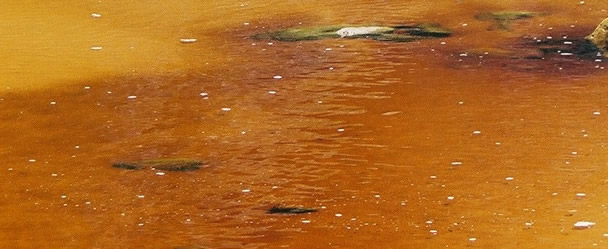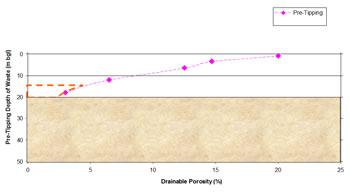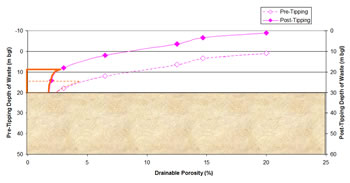Detail of Landfill HRA Experience
Nick has extensive experience in Landfill Hydrogeological Risk Assessment (HRA) see the following subsections for further details:
- NCC Dilute and Disperse Sites
- Shanks / WRG Oxford Clay Sites
- Hydraulic Containment
- Other Site Types
- Impacts of Overtipping / Surcharging
- Training
- Good Understanding of Sites
- National Guidance
- Tools
NCC Dilute and Disperse Sites
Nick has been undertaking hydrogeological risk assessments for landfills since 1996. One of his first main pieces of work was looking at the risks to groundwater posed by five former dilute and disperse sites for Norfolk County Council (NCC). Significant effort was invested in pinning down what was happening (hydrogeologically) at each site. Although the work stretched the budget, the outputs were well received by the client. Furthermore, a senior member of a large consultancy who now work on the operational parts of these sites (for a different client) has kindly noted that the 1996 NCC reports that Nick prepared still form the sound (‘authoritative’) basis for understanding these sites. The work therefore appears to have stood the test of time (so far!).
Shanks / WRG Oxford Clay Sites
Nick commenced working on a number of former Shanks landfill sites circa 1996/7 with the preparation of Regulation 15 groundwater risk assessments. Many of the sites were former Oxford Clay, clay pit sites including the ~140 ha Brogborough Landfill site, but other sites included one situated in a Lower Chalk / Gault Clay / Woburn Sand setting, in Ruabon Marls, and in Lincs Limestone / Northampton Sand Ironstone. Nick’s support on many of these sites continued through the preparation of PPC Permit supporting hydrogeological risk assessments in 2003 and remained in place following Waste Recycling Group’s (WRG’s) purchase of the Shanks sites. A summary of Nick’s work at Entec UK Ltd on the Brogborough Landfill site is available on page 16 of Entec’s Water Management capability statement (See Reference #11 on Downloads page).
In 2013, Nick supported URS and FCC Environment (which includes the former WRG) by preparing a revised hydrogeological risk assessment for part of the Calvert landfill site, examining impacts from proposed non-hazardous and hazardous waste cells.
Hydraulic Containment
Many of the former Shanks / now WRG Oxford Clay sites have their base below the piezometric level of the underlying Kellaways Sand and this means they have the potential to be operated under the principles of hydraulic containment. That is, no basal outward leakage of leachate and limited groundwater ingress. Before the Environment Agency released its guidance (See Reference #12 on Downloads page) on predicting risks to groundwater from hydraulically contained sites, Nick developed spreadsheets and calculations, which considered the rate of inward movement of groundwater and the outward diffusion and attenuation of contaminants.
Nick also worked closely with local Environment Agency staff to agree a method of risk assessment for these sub-water table sites. One of the issues in the late 1990s was the need to provide a context on how many subwater table / hydraulically contained sites there were nationally. This was addressed through a landfill tax funded project (See Reference #16 on Downloads page) in which Nick was involved and through a report that Nick was the final report editor. This report is referenced in the Environment Agency’s review (See Reference #13 on Downloads page) of hydraulic containment of landfills. Further issues were raised by the Environment Agency such as the effect of high groundwater levels on waste stabilisation, gas generation and control and stability. A second landfill tax funded project (See Reference #17 on Downloads page) was managed by Nick to address these questions and also to look in more detail for evidence of groundwater ingress and any evidence of impact on groundwater quality.
Nick’s work in this area led to him being appointed by the Environment Agency’s Anglian Region in 2008, as technical expert to review the feasibility of operating a landfill site under the principles of hydraulic containment.
In 2014, Nick was appointed in a similar role by Natural Resources Wales to evaluate the evidence for past and current hydraulic containment at a site in north-eastern Wales.
Other Site Types
In addition to the specific examples given above, Nick has undertaken or reviewed hydrogeological risk assessments for the following site settings:
- Coal Measures (former open cast coal mines, West Midlands, Wales, Cumbria and Scotland);
- Mercia Mudstone (former brick clay pits, West Midlands and Somerset);
- Ordovician Slate (former slate mine, North Wales);
- Glacial and recent deposits (sand and gravel pits and land raises, N Wales, Scotland);
- Carboniferous Limestone (deep sub-water table limestone quarry, Gloucestershire).
Impacts of Overtipping / Surcharging
In addition to undertaking the standard hydrogeological risk assessment, Nick also developed a spreadsheet approach to allow the impacts to be assessed of surcharging / overtipping of old waste with new waste. Further details are provided in a presentation (See Reference #14 on Downloads page) Nick gave at a Geological Society national conference on landfill hydrogeology in February 2008 (See Reference #15 on Downloads page). Nick undertook an assessment of the impact of surcharging for an Augean landfill site in 2012 as part of support provided by URS (Scott Wilson).
Impacts of Overtipping on Leachate Levels
These illustrations explain how rises in leachate level due to overtipping are calculated.
The approach allows pre-tipping target leachate levels to be calculated so that on tipping leachate does not rise above a prescribed level.
Nick’s work also looked at the impact on retrofit leachate well yields and spacing, waste stabilisation and leachate quality.
The drainable porosity of waste decreases with depth. Before tipping the leachate level represents a known volume of leachate.
After tipping, the originally saturated waste is now deeper and has lower drainable porosity due to compaction and so the same volume of leachate now needs to occupy a greater thickness of waste. Hence leachate levels rise.
Pulverised Fly Ash (PFA) use in Restoration
Whilst not landfill, Nick has evaluated the potential impact of pulverised fly ash (PFA) as a restoration soil in former gravel workings in Staffordshire. Work was undertaken between 2014 and 2016. Significant effort was invested in understanding the site setting (which included upwelling of brackish water). The work included evaluating the drainage and leaching properties of the material. Despite published statements that PFA self-seals to produce a low permeability material, it appears sufficiently permeable to allow infiltration of the majority of effective rainfall. Its leachate is commonly of elevated pH (>9) and, due to increased solubility of metalloids at high pH, consequently exceeds waste acceptance criteria limits for inert wastes for a number of metals (e.g. molybdenum). Nick evaluated the consequences of significantly reduced pH following mixing with groundwater and significantly reduced mobility of metals.
Inert Landfills
Inert landfills require careful attention. The Waste Acceptance Criteria leaching test limits were set in 2003 to protect water quality as defined by environmental quality standards (EQSs) current at that time. However, EQSs have become more stringent since 2003 for seven metals and phenol, meaning the WAC test safeguards no longer provide the protection they used to. Some metals (copper, nickel, lead and zinc) also have EQSs now based on bioavailable concentrations and bioavailability depends on local water quality. Careful attention to the site setting and design is therefore required to ensure an inert landfill does not harm local water receptors.
There is no requirement to WAC test natural soils if they come from clearly uncontaminated sites. However, where naturally weathered, many sulphide-rich clay formations (e.g. the Oxford Clay or the London Clay) can contain high concentrations of leachable sulphate in excess of WAC limits for inert landfills and if this is not identified could lead to risks to the water environment or the need for leachate extraction or landfill capping; neither of which may have been factored in to the site's business model.
Care must also be taken in inert landfill design. Placement of lining materials with too low a permeability combined with no capping is likely to lead to a build-up of leachate head. This in turn could lead to a risk of over-topping and surface break out or the need for long-term leachate abstraction.
Training
Nick has prepared and delivered (½ - 1 day duration) training courses on landfill hydrogeological risk assessment to Waste Contractors and to Entec UK Ltd staff. He has also prepared a course on Groundwater Trigger and Control Levels.
Good Understanding of Sites
The risks to groundwater from a landfill can best be managed through a good understanding of the site’s design and hydrogeology. This takes more effort, but without this consultants and regulators are likely to be more conservative with their recommendations and requirements on landfill design and operation. Conservativeness usually means more expensive engineering and more onerous operational constraints. Nick co-authored a journal article (See Reference #29 on Downloads page) on this subject in 1998 and has stuck by these principles since that time. His experience in this field does however allow him to identify the important aspects of a site’s setting and design at an early stage.
National Guidance
In August 2009, Nick prepared a legislative update of the Environment Agency’s 2003 national guidance on ‘Hydrogeological Risk Assessment for Landfills and the derivation of Groundwater Control and Trigger Levels’ (See Reference #2 on Downloads page). The legislative update brought the former Groundwater Regulations (1998) and Landfill Regulations (2002) version up to date with the Environmental Permitting Regulations (EPR) brought into force in April 2010. EPR (2010) enact the relevant requirements of the Water Framework Directive (2000/60/EC) and Groundwater Directive (2006/118/EC) for permitted ‘point source’ activities.
Tools
Nick has used LandSim, the Environment Agency’s contaminant fluxes from hydraulic containment landfills spreadsheet (See Reference #12 on Downloads page) and developed his own Excel based tools based on accepted algorithms to evaluate a range of landfill hydrogeological risk assessment scenarios and problems.
* Image used with permission from the Geological Society and Entec UK Ltd.



